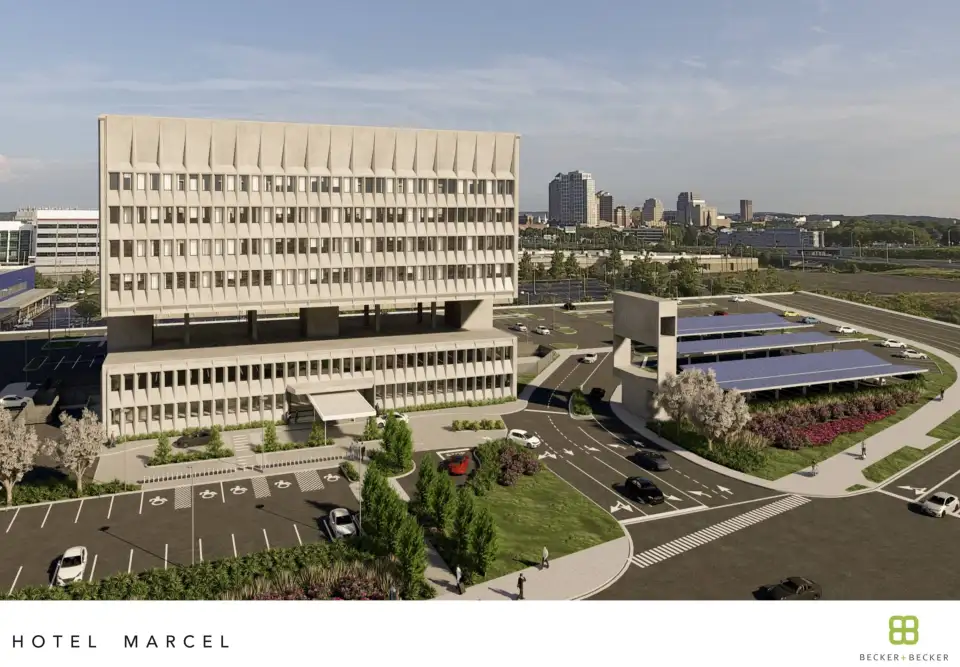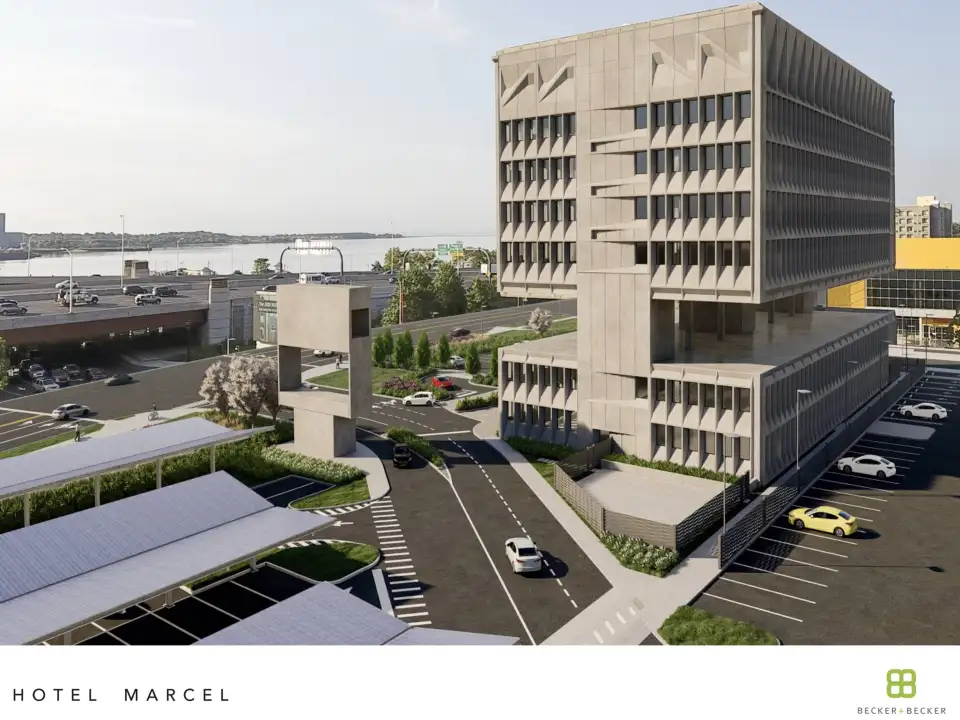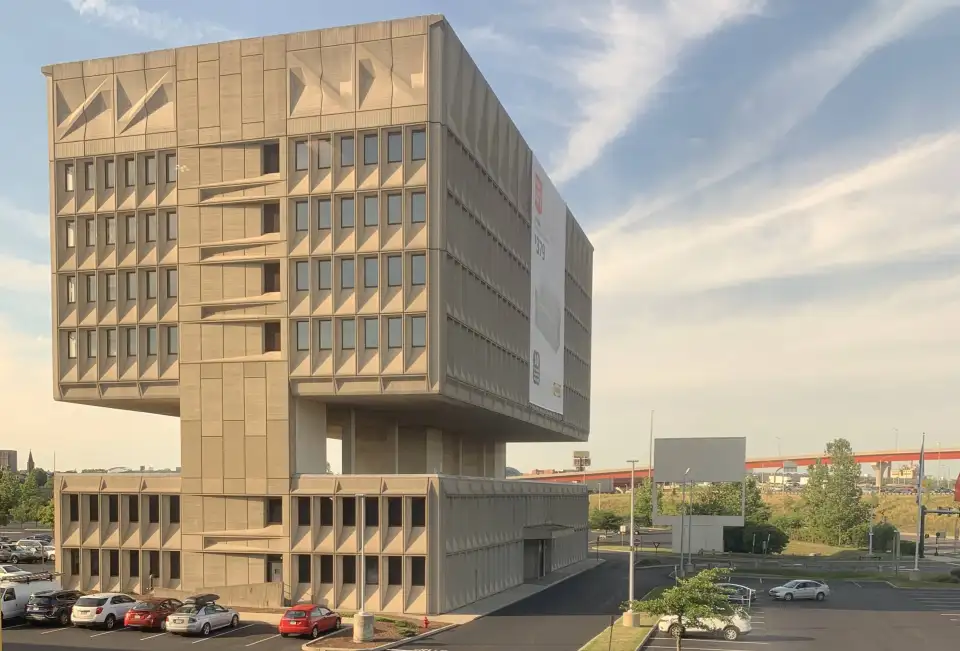
The city of New Haven, Connecticut is home to many firsts. Yale, the first university in the state, calls New Haven home and was founded in 1701. The first public tree planting program in the United States also started in New Haven in 1784, when James Hillhouse began planting elms throughout the city. New Haven is also purportedly the place where the first Hamburger Sandwich was served—in 1895 at Louis’ Lunch.
New Haven will soon get to claim yet another first with Hotel Marcel. Thanks to the Westport-based firm Becker + Becker and Steven Winter Associates (SWA), Hotel Marcel is slated to become the first Passive House hotel in the United States when it opens later this year.
It is certainly not a surprise that a hotel is being built to Passive House standards. The trend toward increasingly efficient buildings has made such a project inevitable. What does come as a surprise is that Bruce Redman Becker—principal of Becker + Becker and the owner, developer, and architect on the project—decided to convert the famed Pirelli building into the EnerPHit certified, 165-room Hotel Marcel. The Pirelli building is a Brutalist masterpiece originally designed by Marcel Breuer in the 1960s. On top of being EnerPHit certified, Becker + Becker also hopes the project will be awarded NetZero, LEED platinum, and Energy Star certifications and to power the hotel exclusively using electricity. This all-electric feat is particularly noteworthy given the hotel’s extensive kitchen and laundry facilities.

More than just figuring out ways to cook French fries in a Passive House kitchen, the project has posed multiple challenges to the design team. Because the Pirelli building is perhaps the Elm City’s most iconic landmark, at least from the stretch of the I-95 freeway that hugs the western bank of the Quinnipiac River, it was added to the State Register of Historic Places in 2000 and to the National Register in 2021. As Lois Arena, SWA’s director of Passive House services, told Zack Semke in an episode of the Passive House Podcast, this means alterations to the façade are off-limits. Consequently, air and vapor barriers, as well as any additional insulation, must be exclusively installed on the building’s interior.
Kate Doherty, building systems analyst with SWA, described the resulting plan in a blog she wrote last summer. “A continuous plane of closed-cell insulation on the interior face of the concrete panels acts as an air barrier and vapor retarder and provides a high R-value for the walls and roof,” she wrote. “The SWA Enclosures team provided detailing of the continuous thermal breaks (aerogel-containing insulating blocks) and condensation control for tight spaces around window and door openings in order to maintain the historic fabric while achieving Passive House and LEED goals.”

The improvements to the building do not stop there. Triple-glazed windows are also being installed, and the hotel will employ energy-saving technologies like 100% LED power-over-ethernet lighting and occupancy sensors for room thermostats once in operation. Meanwhile, the large parking lots adjacent to the structure will be outfitted with enough solar canopies to achieve net zero energy. In Phase 1, a PV system is being installed that is estimated to produce roughly 550,000 kWh per year, while Phase 2’s system, to be installed in 2022, will produce 2.6 million kWh per year.
Becker + Becker is not just turning heads among the high-performance building and Passive House communities. The hospitality industry is also paying close attention to the financial viability of the hotel. Large chains have been willing to install energy-saving appliances and water-efficient devices in their hotels and to urge consumers to use fewer resources, but these green practices often camouflage the fact that hotels lag behind other parts of the real estate sector when it comes to making deep energy retrofits and adopting renewable energy systems.
If the Hotel Marcel can show that its commitment to sustainability significantly reduces operating costs, increases cash flow, and produces a relatively quick return on investment, then more hoteliers will likely follow suit. After all, hotels are long-term investments that tend to have lifespans measured in decades, which means that perennially low operating costs will translate into significant profits. Furthermore, if having a net-zero or Passive House building increases the brand’s green cachet, then noting that the building is certified could be an additional draw for eco-conscious guests. In time, as guests experience a night in a Passive House room and write reviews about their stay—likely noting such features as reduced noise, thermal comfort, and improved air quality—this could bring more awareness of Passive House design to the mainstream. Guests may even come to see Passive House as an amenity in its own right.
While this final point may be overly optimistic, Hotel Marcel stands to be a major milestone for the hotel industry.